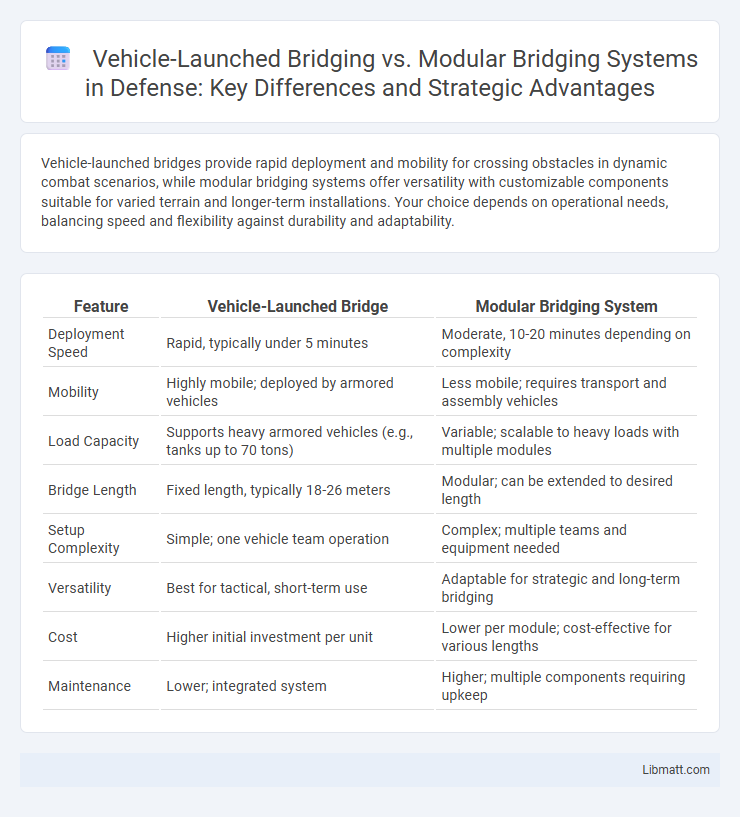Vehicle-launched bridges provide rapid deployment and mobility for crossing obstacles in dynamic combat scenarios, while modular bridging systems offer versatility with customizable components suitable for varied terrain and longer-term installations. Your choice depends on operational needs, balancing speed and flexibility against durability and adaptability.
Table of Comparison
| Feature | Vehicle-Launched Bridge | Modular Bridging System |
|---|---|---|
| Deployment Speed | Rapid, typically under 5 minutes | Moderate, 10-20 minutes depending on complexity |
| Mobility | Highly mobile; deployed by armored vehicles | Less mobile; requires transport and assembly vehicles |
| Load Capacity | Supports heavy armored vehicles (e.g., tanks up to 70 tons) | Variable; scalable to heavy loads with multiple modules |
| Bridge Length | Fixed length, typically 18-26 meters | Modular; can be extended to desired length |
| Setup Complexity | Simple; one vehicle team operation | Complex; multiple teams and equipment needed |
| Versatility | Best for tactical, short-term use | Adaptable for strategic and long-term bridging |
| Cost | Higher initial investment per unit | Lower per module; cost-effective for various lengths |
| Maintenance | Lower; integrated system | Higher; multiple components requiring upkeep |
Introduction to Vehicle-Launched Bridges and Modular Bridging Systems
Vehicle-launched bridges offer rapid deployment by deploying directly from specialized vehicles, enabling quick crossing over obstacles without extensive setup. Modular bridging systems consist of standardized components that can be assembled and adapted on-site, providing flexibility for various terrain and load requirements. Your choice between these bridging solutions depends on mission urgency, terrain complexity, and the required load capacity.
Key Design Principles: Vehicle-Launched vs. Modular Bridges
Vehicle-launched bridges are engineered for rapid deployment and mobility, featuring integrated launching mechanisms that enable a single vehicle to carry, deploy, and retrieve the bridge without external equipment, prioritizing speed and tactical flexibility. Modular bridging systems emphasize adaptability and scalability, consisting of standardized, interchangeable components that can be assembled into various configurations to accommodate different span lengths and load requirements. Understanding these key design principles helps you select the optimal bridge type based on operational speed, logistical constraints, and mission-specific structural needs.
Deployment Speed and Operational Efficiency
Vehicle-launched bridges offer rapid deployment by eliminating the need for extensive assembly, enabling forces to quickly overcome obstacles during combat operations. Modular bridging systems require multiple components to be transported and assembled on site, which can slow down the process but allows for greater customization and scalability. Your choice impacts operational efficiency, with vehicle-launched bridges prioritizing speed and modular systems providing flexibility for diverse mission requirements.
Mobility and Accessibility in Challenging Terrains
Vehicle-launched bridges offer rapid deployment and enhanced mobility in rugged and combat zones, enabling forces to quickly cross water obstacles without requiring extensive assembly. Modular bridging systems provide greater flexibility and adaptability for diverse terrains, allowing customization and scalability for various gap widths and load capacities. Both systems improve accessibility in challenging environments, but vehicle-launched bridges prioritize speed, while modular systems emphasize versatility in complex terrain navigation.
Load Capacity and Structural Performance
Vehicle-launched bridges typically offer higher load capacities due to their rigid construction and integration with heavy-duty vehicles, enabling the support of main battle tanks and other armored vehicles. Modular bridging systems provide flexible structural performance by allowing quick assembly and configuration adjustments, but may have lower load limits compared to vehicle-launched options. Your choice depends on the required load-bearing demands and operational speed, with vehicle-launched bridges excelling in heavy load scenarios and modular systems favored for adaptability.
Flexibility and Adaptability in Field Conditions
Vehicle-launched bridges offer rapid deployment and mobility, allowing forces to quickly adapt to changing battlefield environments by bridging gaps without extensive setup time. Modular bridging systems provide enhanced adaptability through configurable components that can be tailored to diverse terrains and load requirements, ensuring reliable support across varied field conditions. Both systems prioritize flexibility but differ in operational scope, with vehicle-launched bridges excelling in speed and modular systems in customizable versatility.
Logistics, Transport, and Setup Requirements
Vehicle-launched bridges eliminate the need for heavy transport equipment since they deploy directly from the carrier vehicle, streamlining logistics and reducing setup time. Modular bridging systems require multiple transport vehicles and cranes for assembly, increasing the complexity and duration of deployment. Your mission efficiency improves with vehicle-launched bridges due to their rapid setup and reduced logistical footprint compared to modular alternatives.
Cost Comparison: Acquisition, Maintenance, and Lifecycle
Vehicle-launched bridges typically have higher initial acquisition costs due to integrated deployment mechanisms and specialized chassis requirements. Modular bridging systems offer lower upfront expenses and greater flexibility but may incur increased maintenance and assembly labor costs over their lifecycle. Lifecycle analysis often favors vehicle-launched bridges for rapid deployment and reduced manpower, whereas modular systems benefit from easier part replacement and adaptability to varied terrains.
Applications in Military and Civilian Operations
Vehicle-launched bridges offer rapid deployment and mobility critical for military operations, enabling forces to quickly traverse obstacles like rivers and ravines in combat zones. Modular bridging systems provide versatile solutions for both military logistics and civilian infrastructure projects, allowing customizable spans suitable for temporary or emergency crossings. Their applications extend to disaster relief efforts and infrastructure repair, supporting fast restoration of transportation networks in inaccessible or damaged areas.
Future Trends and Technological Advancements
Vehicle-launched bridges are evolving with advancements in lightweight composite materials and automated deployment systems, enhancing rapid response capabilities in complex terrains. Modular bridging systems benefit from innovations in scalable design and interoperability, allowing for customizable configurations that meet diverse military and civil engineering demands. Integration of digital twin technology and AI-driven predictive maintenance is shaping future trends, improving the operational lifespan and real-time monitoring of both bridging solutions.
vehicle-launched bridge vs modular bridging system Infographic

 libmatt.com
libmatt.com